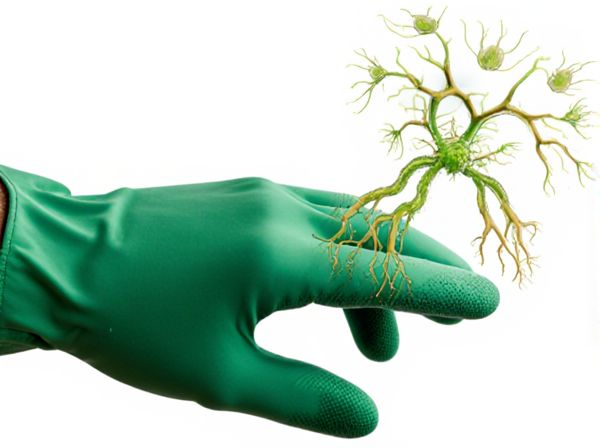
Rooting Hormone vs Natural Rooting Illustration
Rooting hormone accelerates propagation by stimulating faster root development through synthetic auxins, ensuring higher success rates and uniform plant growth. Natural rooting methods rely on endogenous plant hormones found in willow water, honey, or aloe vera, offering an organic approach but with variable results. Choosing between synthetic rooting hormone and natural alternatives depends on propagation goals, plant species, and environmental conditions.
Table of Comparison
| Feature | Rooting Hormone | Natural Rooting |
|---|---|---|
| Definition | Commercially formulated chemical rooting agents | Using organic materials like honey, willow water, or aloe vera |
| Effectiveness | High success rate with faster root development | Moderate success rate, slower root formation |
| Active Ingredients | Indole-3-butyric acid (IBA) or naphthaleneacetic acid (NAA) | Natural auxins and growth stimulants from plants |
| Application | Direct powder or liquid application on cuttings | Soaking cuttings in natural extracts or using raw materials |
| Cost | Commercially priced, varies by brand and concentration | Low cost, easily accessible materials |
| Environmental Impact | Potential chemical residues, controlled usage recommended | Eco-friendly, biodegradable |
| Suitability | Ideal for commercial nurseries and large-scale propagation | Best for home gardeners and organic practices |
Understanding Rooting Hormones: An Overview
Rooting hormones accelerate vegetative propagation by stimulating cell division and root initiation in cuttings, improving success rates, especially in difficult-to-root species. Synthetic auxins like indole-3-butyric acid (IBA) and naphthaleneacetic acid (NAA) are commonly used rooting hormones that enhance root development faster than natural methods. Natural rooting relies on the plant's inherent ability to produce endogenous hormones but often results in slower root formation and lower uniformity compared to hormone-treated cuttings.
Natural Rooting Methods Explained
Natural rooting methods rely on the plant's own hormones and environmental conditions to encourage root development, often using water, soil, or organic mediums like peat or coconut coir. Techniques such as stem cuttings placed in water or directly into a moist growing medium leverage the plant's innate ability to generate roots without synthetic additives. These methods promote healthier root systems by mimicking natural growth conditions, enhancing nutrient absorption and transplant success rates.
Key Differences: Synthetic vs Natural Rooting Agents
Rooting hormone contains synthetic auxins like indole-3-butyric acid (IBA) that accelerate root initiation, offering faster and more uniform propagation results compared to natural rooting agents derived from substances like willow water or honey. Synthetic rooting hormones provide consistent concentrations of growth regulators, ensuring reliable root development under controlled nursery environments. In contrast, natural rooting agents vary in chemical composition and efficacy, often resulting in slower rooting processes but appealing for organic or low-chemical cultivation practices.
Benefits of Using Commercial Rooting Hormones
Commercial rooting hormones significantly increase the success rate of plant propagation by stimulating rapid root development through synthetic auxins like indole-3-butyric acid (IBA). These products reduce the time needed for cuttings to establish roots, leading to stronger, healthier plants and higher transplant survival rates. Using commercial rooting hormones ensures consistency and reliability compared to natural rooting methods, which can vary due to environmental factors and plant species.
Advantages of Natural Rooting Alternatives
Natural rooting alternatives promote healthier root systems by enhancing microbial activity and improving soil aeration, which leads to stronger, more resilient plants. These methods reduce chemical exposure, ensuring safer, eco-friendly propagation practices suitable for both home gardeners and commercial growers. Utilizing organic materials like willow water or honey supports sustainable horticulture by fostering natural growth hormones and reducing environmental impact.
Common Types of Rooting Hormones for Gardeners
Common types of rooting hormones for gardeners include auxin-based products such as indole-3-butyric acid (IBA), naphthaleneacetic acid (NAA), and indole-3-acetic acid (IAA), which stimulate root initiation and growth. Synthetic formulations often contain IBA or NAA for enhanced consistency and effectiveness compared to natural alternatives like willow water or honey. These hormones improve propagation success rates by accelerating root development and increasing the uniformity of cuttings.
Popular Natural Rooting Solutions and Ingredients
Popular natural rooting solutions often include ingredients such as willow water, honey, and cinnamon, known for their hormone-like properties that stimulate root development. Willow water contains natural auxins that enhance cell division and root initiation, while honey acts as an antimicrobial agent preventing infections and promoting healthy growth. Cinnamon powder serves as both a rooting enhancer and a natural fungicide, making these ingredients effective alternatives to synthetic rooting hormones in propagation.
Effectiveness: Rooting Hormones Compared to Natural Methods
Rooting hormones significantly increase propagation success rates by accelerating root development through synthetic auxins like indole-3-butyric acid (IBA) or naphthaleneacetic acid (NAA), promoting quicker and more robust root formation compared to natural methods. Natural rooting, relying on endogenous plant hormones and environmental factors, exhibits variable effectiveness influenced by plant species, cutting type, and environmental conditions, often resulting in slower root emergence and lower uniformity. Studies show rooting hormones can improve root initiation frequency by up to 70%, making them a reliable choice for commercial propagation where consistency and speed are critical.
Safety and Environmental Impact of Rooting Approaches
Natural rooting methods minimize chemical exposure, reducing health risks for gardeners and environmental contamination. Rooting hormones, often synthetic or containing auxins like IBA or NAA, can accelerate propagation but may introduce ecological concerns if overused. Sustainable propagation favors organic or hormone-free techniques to ensure safety and lower environmental impact while promoting plant health.
Choosing the Best Rooting Method for Your Garden
Choosing the best rooting method for your garden depends on plant species, growth goals, and time constraints. Rooting hormone accelerates root development by supplying synthetic auxins, increasing success rates for hardwood and semi-hardwood cuttings. Natural rooting through water or soil propagation supports organic growth but may require more patience and specific environmental conditions.
Rooting Hormone vs Natural Rooting Infographic

 gardendif.com
gardendif.com